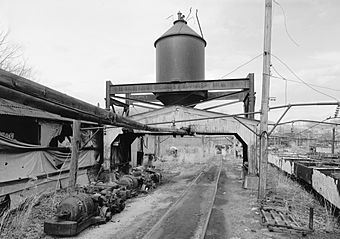Berwind-White Mine 40 Historic District facts for kids
Quick facts for kids |
|
|
Berwind-White Mine 40 Historic District
|
|

Sand tank at Eureka No. 40, March 1988
|
|
| Location | Roughly bounded by the boney pile, Eureka No. 40 mine site, Scalp Level Borough line and Berwind-White Farmstead, Richland Township and Scalp Level, Pennsylvania |
|---|---|
| Area | 194 acres (79 ha) |
| Built | 1905–1941 |
| Architect | Windber Lumber Co. |
| Architectural style | Utilitarian industrial |
| NRHP reference No. | 92000392 |
| Added to NRHP | April 28, 1992 |
The Berwind-White Mine 40 Historic District is a special place in Richland Township and Scalp Level, Pennsylvania. It's called a historic district because it's an area with many old buildings and sites that tell an important story about the past. This district was once a busy coal mine and the town where the miners lived.
This historic district was developed between 1905 and 1941 by the Berwind-White Coal Mining Company. It includes 121 important buildings, 2 special sites, and 4 structures that help us understand what life was like back then.
What Was Mine 40?
Mine 40 was a large coal mine operated by the Berwind-White Coal Mining Company. Coal mining was a very important industry in Pennsylvania. Miners would dig deep underground to bring out coal, which was used to power factories, heat homes, and run trains.
The district isn't just about the mine itself. It also includes the "patch community." This was a small town built by the mining company specifically for its workers and their families. It was a complete community where people lived, worked, and went to school.
Buildings at the Mine Site
Many different buildings were needed to run a coal mine and support the community. Some of the important buildings and structures at Mine 40 included:
- Over 100 two-story homes for the miners and their families. These were often called "double housing" because two families might share one building.
- A power house, which generated electricity for the mine operations.
- Drift openings, which were the entrances to the underground mine tunnels.
- A cleaning plant, where the coal was processed and cleaned after being mined.
- A motor barn, used for storing and repairing the machines that moved coal.
- A fan house, which helped with air circulation inside the mine for safety.
- A sand tank, likely used for preparing sand for various mine processes.
- A railroad repair car shop, where train cars used to transport coal were fixed.
- A wash house, where miners could clean up after a long, dirty day of work.
Why is it a Historic District?
The Berwind-White Mine 40 Historic District is important because it shows us how coal mining communities were built and how people lived in the early 1900s. It helps us understand the history of industry and daily life in Pennsylvania.
Because of its importance, the district was added to the National Register of Historic Places in 1992. This is an official list of places in the United States that are considered worthy of preservation because of their historical significance.
Sadly, most of the original Eureka No. 40 coal mine complex was taken down in 2011 and 2012. Only the power house remains today. Even though many buildings are gone, the district is still recognized for its historical value.



